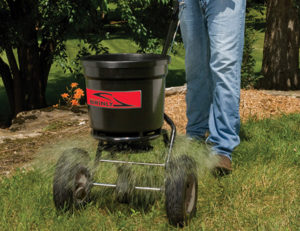
If you have a large property, you know that you need the right lawn care attachments to achieve your goals of natural lawn care.
In this blog post, you’ll learn pro tips to employ natural lawn care on your property as well as the expert lawn attachments that will help you achieve a healthy yard, including
· 10 tips for using natural lawn care techniques this season
· The perfect lawn care attachments for a healthy, natural lawn.
10 Tips for Using Natural Lawn Care Techniques This Season
Using natural lawn care for your property starts with realizing that some of the lawn care information you might’ve learned needs to be changed. For example, homeowners used to think that leaving grass clippings on the turf caused thatch.
But you can change your way of doing lawn care by starting to think like a farmer. Here are 10 tips for using natural lawn care techniques:
1. Know your grass type
There are two types of grasses: cool- and warm-season. You'll plant cool season grasses if you live in the northern part of the U.S. and Canada.
If you live in the temperate middle of the U.S., you’ll plant a mix of cool- and warm-season grasses. And if you live in the southern U.S., you use warm-season grasses.
You can learn more about warm- and cool-season lawns in these blogs,
· Your Month-by-Month Lawn Care Schedule for Warm Season Grasses
· Month-by-Month Lawn Care Calendar for Cool Season Grasses.
2. Consider planting clover
At one time, it was normal to have clover growing in lawns. Nowadays, some homeowners look at clover as a weed. However, they’re missing out on this nitrogen source that also makes turf more tolerant of dog urine, drought, and poor soil quality.
Read more: Your Guide to Planting a Clover Lawn.
3. Test your soil
Before applying fertilizer, determine what nutrients are missing from your soil. Most land-grant university extensions offer soil testing for a small fee.
Learn more about the importance of soil in these two blog posts:
· How Often Do I Need to Check My Soil?
4. Aerate your lawn at the right time of year
Lawn aeration allows sunlight, oxygen, and nutrients to penetrate deeper into the soil, improving seed germination and soil health.
You aerate for cool-season grasses in the fall, and warm-season lawns require springtime aeration.
Learn more about aeration in these two blog posts:
· How Often to Aerate Your Lawn
· Fall is the Time to Core Aerate & Overseed.
5. Dethatch your lawn during the years you don’t aerate
Turf experts recommend aerating your lawn every two years. In the off years, the experts recommend de-thatching to protect your turf from disease and insect infestation.
You can read more about dethatching in these posts:
· What Is a Dethatcher? And How to Correctly Dethatch Your Lawn
· Do You Want a Healthy Lawn? Then Dethatch It.
6. Mow your lawn at the right height
Cutting your grass is more than hopping onto your riding mower. You need to consider the time of day, the season, and the sharpness of your mower blades.
You may also want a striped lawn, which requires professional-grade mowing. Here are two blog posts dedicated to mowing your lawn:
7. Use Integrated Pest Management (IPM)
IPM means limiting pest control and introducing “good” bugs into your ecosystem. For example, plant a variety of grasses, including clover and other drought-tolerant grasses.
You can also use fences to keep deer and ticks off your property. To kill different insects, you can introduce beneficial nematodes and Bacillus thuringiensis.
8. Recycle grass clippings for up to a 25% nitrogen boost
Use your mower’s mulch setting to finely chop up grass clippings so that they absorb back into the soil. Additionally, you can collect your grass clippings and put them in your garden for extra nitrogen.
9. Fertilize your lawn with organic nutrients
Switch to organic fertilizers for your lawn. Again, follow the manufacturer’s directions for your grass type and the season. Also, use the recommended nutrient ratios (0-0-0) listed on your soil test results.
10. Water infrequently and deeply
Improve the soil and use the right amount of fertilizer to reduce your lawn’s water usage. You only need to water your lawn 1”-1 ½” weekly, but ensure you water it deeply.
Also, if there is any rain during the week, subtract that from the water you use on your lawn.
Following the above tips for natural lawn care will also keep your turf healthy and thriving even during summer heat. Read more in this blog post, How to Keep a Healthy Lawn during the Hot Summer.
The Perfect Lawn Care Attachments for a Healthy, Natural Lawn
At Brinly, we have the perfect lawn care attachments to achieve a natural lawn. Our quality lawn products are now 20% off, excluding service parts.
Choose from the following lawn attachments to succeed in all of your natural lawn care goals:
· Lawn Dethatchers
· Lawn Rollers
· Lawn Sprayers
· Lawn Sweepers
· Push Spreaders
· Spike & Plug Aerators
· Tow-Behind Carts
· Tow Spreaders
· ZTR Products.
Don’t Delay: Get 20% Off Your Brinly Lawn Attachments!
This sale won’t last forever. Use the code LAUNCH at checkout to take 20% off your Brinly Lawn & Garden Products.
Find your favorite Brinly Lawn & Garden Equipment at these fine retailers. If you have a question about your Brinly tools? Contact customer service.
Sources:
LawnLove.com, Integrated Pest Management for the Lawn.
